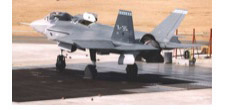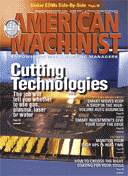| |
<
Back to Articles

Armor
for tools
With
The Right Protective Coating, Tools Last Longer And Cut Better.
By James Benes, American
Machinist, June 2007
| |
Selecting
the right coating for tooling — based on the application
— is one of the most important factors to ensure effective
machining. The right choice of coating can cut tooling costs
per job or per piece because it can leed to reduced friction;
less heat development, less cold welding, reduced cutting forces;
increased feed and speed rates; improved workpiece surface quality
and reduced downtime. Choosing the right coating for an application
can be a confusing and arduous task. Each coating that is available
has advantages and disadvantages, and the wrong choice can cut
tool life and can multiply problems. |
What to look for
in a coating
 Hardness
is critical in a coating because the harder the material or surface,
the longer the tool will last. With a surface hardness near 9,000
HV, CVD diamond coatings that have been grown onto the tools have
as much as 20 times better tool life compared to PVD coatings. This
is the coating of choice for cutting nonferrous materials because
of its higher hardness and its ability to run at two to three times
the speed of uncoated tooling. Hardness
is critical in a coating because the harder the material or surface,
the longer the tool will last. With a surface hardness near 9,000
HV, CVD diamond coatings that have been grown onto the tools have
as much as 20 times better tool life compared to PVD coatings. This
is the coating of choice for cutting nonferrous materials because
of its higher hardness and its ability to run at two to three times
the speed of uncoated tooling.
Wear resistance is the ability of the coating to
protect against abrasion. Although a material may not be hard, elements
and processes added during production may aid in the breakdown of
cutting edges or forming lobes.
Surface lubricity is important because a high coefficient
of friction causes increased heat that shortens the life of a coating
or causes the coating to fail. However, a lower coefficient of friction
increases tool life. A slick surface — one that lacks coarseness
or irregularities — lets chips slide off the face of the tool,
and generates less heat. High surface lubricity also allows for
increased speeds, when compared with tools that are not coated,
and helps to prevent galling of the workpiece.
Oxidation temperature is the point at which the
coating starts to break down. A high oxidation temperature rating
improves success in high heat applications.
Anti-seizure capability keeps material from depositing
onto the tool by preventing chemical reactivity between the tool
and the cutting material. This capability reduces built up edge
(BUE), a problem that is common when machining nonferrous materials
such as aluminum or brass, leads to chipping of the tool or oversizing
of the part. Once material starts adhering to the tool, it continues
to attract more material.
Common coatings
Titanium nitride (TIN) is a general purpose coating
produced by the physical vapor deposition (PVD) process. This coating
has a surface hardness of 81 HRc and a coefficient of friction of
0.4. It is thermally stable to 1,000f (550C), and is suited to cutting
a variety of materials including iron-based materials, unalloyed
and alloyed steels and hardened steels with high-speed steel (HSS)
tooling.
Titanium carbonitride (TiCN) has more carbon than
tin for higher hardness (90HRc) and better surface lubricity (coefficient
of friction of 0.3). This coating also is good for HSS cutting tools
and, with increased wear resistance, is good for machining more
difficult-to-machine materials such as cast iron, aluminum alloys,
tool steels, copper, inconel, titanium alloys and nonferrous metals.
Titanium aluminum nitride (TiALN) is a high performance
coating with a surface hardness in the upper 80-HRc range. It holds
its hardness at high temperatures due to a layer of aluminum oxide
that forms between the tool and the cutting chip that transfers
heat away from the tool and into the part or chip. Its superior
oxidation resistance provides unparalleled performance in high-temperature
machining. Because carbide tooling is run at higher speeds than
HSS with little to no coolant, TiALN is the preferred choice when
coating carbide. With a coefficient of friction less than that of
tin, tiain excels at machining abrasive and difficult-to-machine
materials such as cast iron, aluminum alloys, tool steels, and nickel
alloys. The coating's high ductility makes it a good choice for
interrupted-cutting operations.
Aluminum titanium nitride (AlTiN), with a higher
aluminum content than TiALN, has a higher surface hardness and also
forms a layer of aluminum oxide for good tool life in high-heat
applications and is a viable option for high-speed machining.
Titanium diboride (TiB2) coating is harder than
TiN and TiALN coatings and has an extremely smooth surface, resulting
in low surface friction, speedy chip flow, and high wear resistance.
In addition, built-up edge is prevented because this coating has
a very low affinity for aluminum. The coating is recommended for
applications in silicon aluminum, titanium, magnesium and copper
alloys.
Chromium nitride (CrN), also known as rainbow coating,
has characteristics and capabilities that surpass other coatings.
With high corrosion resistance, hardness (90 to 92 HRc), wear and
abrasion resilience and heat transformation, CrN is good for virtually
all materials including high silicon aluminum, stainless steel,
high nickel alloys, titanium and composite materials. With an extremely
low coefficient of friction of 0.027, CrN's lubricity surpasses
that of TiN, TiCN, TiAIN and ZrN coatings. The anti-seizure properties
of this coating make it preferred in situations where built-up edge
is common. CrN coatings have a thickness of .00065 in., and help
to ensure that machined products maintain tolerances.
Diamond coatings, produced by the chemical vapor
deposition (CVD) process, offer the highest performance available
for nonferrous materials. They are suitable for cutting graphite,
metal matrix composites (MMC), high silicon aluminum and many other
abrasive materials. Diamond coatings should not be used for machining
steels because the heat generated causes chemical reactions that
break down the bonds that hold this coating to the tool.
DIAMOND COATING CURES COMPOSITIE
MACHINING WOES
An advanced composite wing skin material for the F-35 Joint Strike
Fighter was a headache for components manufacturer Lockheed Martin
Aeronautics Co. The tooling the company was using had short life
and produced excessive delamination on the carbon composite material.
The National Center for Defense Manufacturing and Machining and
its alliance Partners— Amamco Tool Co., Diamond Tool Coating,
Kennametal Inc., McCullough Machine and MDT Inc.—developed
an approach that was aimed at improving router geometry and material,
and the tool's coating.
DiaTiger® diamond coating produced by Diamond Tool Coating LLC
(www.diamondtc.com) was chosen as the coating for the router. This
coating gains strong protection against abrasive wear, galling,
adhesive wear and cutting edge damage from mechanical shock from
its interlocking layers of uniquely structured diamond crystals.
The DiaTiger® Coating is recommended for difficult-to-machine
nonferrous metals and composites.
The new tooling strategy produced dramatic improvements for the
life of the tools that Lockheed Martin was using. The number of
tools needed per wing skin was reduced from 24 to 2 - one to rough
and one to finish. Cutting distance increased six-fold - from 9
linear feet at one-third the total material thickness to 57 linear
feet at full material thickness. These
improvements produced a savings of $80,000 per aircraft.
|





 Hardness
is critical in a coating because the harder the material or surface,
the longer the tool will last. With a surface hardness near 9,000
HV, CVD diamond coatings that have been grown onto the tools have
as much as 20 times better tool life compared to PVD coatings. This
is the coating of choice for cutting nonferrous materials because
of its higher hardness and its ability to run at two to three times
the speed of uncoated tooling.
Hardness
is critical in a coating because the harder the material or surface,
the longer the tool will last. With a surface hardness near 9,000
HV, CVD diamond coatings that have been grown onto the tools have
as much as 20 times better tool life compared to PVD coatings. This
is the coating of choice for cutting nonferrous materials because
of its higher hardness and its ability to run at two to three times
the speed of uncoated tooling.